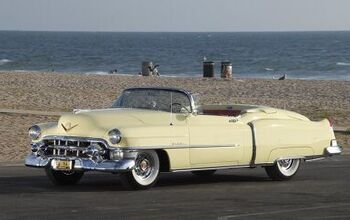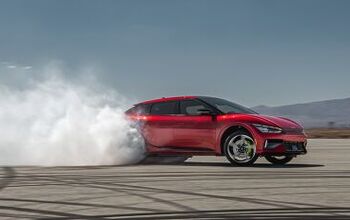Polestar to Utilize Former Saab Plant as European R&D Facility

Polestar is reportedly taking over Saab's defunct plant in Sweden to expand upon its European research and development operations. The 15,000-square-meter building, located in Trollhattan, is said to be focusing on the brand’s powertrain development.
Automobilwoche, and Western-counterpart Automotive News, reported that the site will first attempt to tackle the all-electric motors going into the Polestar 5 (a rival for the Tesla Model S) and the Polestar 6 roadster. The company will reportedly be renting the facility from the city of Trollhattan.
The site was last used by National Electric Vehicle Sweden (NEVS) after Saab folded in 2011. Its plan was to manufacture electric vehicles based on Saab’s 9-3 platform by 2017 and had acquired the necessary assets to accomplish this. Unfortunately, NEVS likewise collapsed after Chinese parent company Evergrande was revealed to be in copious amounts of debt.
From Automotive News:
Polestar also has R&D facilities in Gothenburg, Sweden, which is about 90 km south of Trollhattan, and in Coventry, England. In England the automaker is developing its own lightweight bonded-aluminum platform that will underpin Polestar 5 and Polestar 6.
The Polestar 5, which will also compete against the Porsche Taycan, is scheduled to go into production in 2024 at a plant in Chongqing, China. The Polestar 6 hardtop convertible will also be built at the plant, likely starting in 2025. The plant is owned by Geely and operated by Polestar. Polestar's new platform has not been named yet.
The cars will share an 800-volt electric architecture that in addition to providing nearly 900 hp of power will offer 900 newton meters of torque, 0 to 100 kph (62 mph) acceleration in 3.2 seconds, a top speed of 250 kph (155 mph) and an estimated range of more than 480 km (300 miles), the automaker said.
Despite technically being a Swedish automotive brand tied to Volvo Cars, both companies are presently subsidiaries of China’s Geely and Polestar production takes place in Asia. When asked about the possibility of the Trollhattan site being used to manufacture automobiles, the company stated that it would continue relying on preexisting factories.
While the brand sells in limited quantities, targeting just 80,000 units annually, it’ll still need to find space at the other plants — many of which already build higher-volume products intended for other marquees and have additional Polestar products on the docket.
The mid-sized Polestar 2 is currently manufactured in Luqiao, China, and shares the Compact Modular Architecture (CMA) platform used by a slew of vehicles wearing Lynk & Co, Geely, and Volvo emblems.
While the Polestar 3 and 4 haven’t yet gone on sale, they’ll also be sharing space. The 3 is a large SUV that utilizes the updated Scalable Product Architecture (SPA) platform responsible for some of Volvo’s larger products built in Chengdu, China, and Charleston, South Carolina.
Meanwhile, the Polestar 4 is supposed to be a “coupe-like” SUV underpinned by the Sustainable Experience Architecture (SEA) platform designated for a slew of EVs from Volvo, Geely, Smart Automobile, Zeekr, and even Lotus. The Polestar 5 is also assumed to use the SEA platform, resulting in early rumors that it will likewise be assembled in Hangzhou Bay, China. But that no longer appears to be the case.
In the interim, the Trollhattan facility will be responsible for powertrain development and battery testing and Polestar's attempts to become profitable. While it has reduced its production capacity after failing to reach last year’s target volume, the company still thinks it can achieve 290,000 global sales by 2025 and become a money-maker by 2024.
[Image: Robert Way/Shutterstock]
Become a TTAC insider. Get the latest news, features, TTAC takes, and everything else that gets to the truth about cars first by subscribing to our newsletter.

A staunch consumer advocate tracking industry trends and regulation. Before joining TTAC, Matt spent a decade working for marketing and research firms based in NYC. Clients included several of the world’s largest automakers, global tire brands, and aftermarket part suppliers. Dissatisfied with the corporate world and resentful of having to wear suits everyday, he pivoted to writing about cars. Since then, that man has become an ardent supporter of the right-to-repair movement, been interviewed on the auto industry by national radio broadcasts, driven more rental cars than anyone ever should, participated in amateur rallying events, and received the requisite minimum training as sanctioned by the SCCA. Handy with a wrench, Matt grew up surrounded by Detroit auto workers and managed to get a pizza delivery job before he was legally eligible. He later found himself driving box trucks through Manhattan, guaranteeing future sympathy for actual truckers. He continues to conduct research pertaining to the automotive sector as an independent contractor and has since moved back to his native Michigan, closer to where the cars are born. A contrarian, Matt claims to prefer understeer — stating that front and all-wheel drive vehicles cater best to his driving style.
More by Matt Posky
Latest Car Reviews
Read moreLatest Product Reviews
Read moreRecent Comments
- V8fairy I am starting to see some red emerging on the roads lately. We also have a lot of used import Toyota Aquas and some of them are in really cool colours, like orange, electric blue and bright yellow. What I really miss is colourful interiors, I'd love a bordello red crushed velvet interior, that'd sell me on an EV
- Ted Bryant Agree with Mikey.Manual. Any manual transmission car. 1) can't text-and-drive, 2) forces driver to pay attention, 3) perfect security because most thieves can't drive stick, 4) fun to drive, 5) friends won't drive the car (they can't drive stick), 6) compression start -- never get stuck, and 7) will always be able to drive any vehicle anywhere. Did this for both kids -- after a couple weeks of complaining, they finally got to it, and now only drive manual. And they are both great drivers. But their friends do poke them for driving stick -- "oh neat - a manual. do you bake your own bread and sew your own clothes too..."
- Mikey My youngest girl ( now 48 ) dated a guy that had a Beretta with a stick shift. The Dude liked Beer and weed. too much for my liking..I borrowed my buddy's stick shift Chevette and give her short course on driving a manual .. I told her if the new BF has more than 2 beer or any weed ..You drive ...I don't care how many times you stall it, or or of you smoke the clutch . She caught on quite well ,and owned a succession of stick shift vehicles...An as an added bonus she dumped the guy.
- Blueice "Due to regulation/govt backing, China is poised to dominate BEV/battery production, just as they do solar panel production, drone production, etc.Taiwan dominates production of certain types of chips due to regulation/govt backing and we saw how precarious such a situation is (especially with the PRC increasingly becoming aggressive towards Taiwan).That's why regulation/govt backing is aiming to build up local chip manufacturing."BD2, these businesses and or industries are not free market enterprises, buttcorporatist, bent on destroying their competitors with the use of governmentalunits to create monopolies. How safe are world consumers when the preponderance of computer chipsare made in one jurisdiction. Do you what Red China controlling any industry ??And it is well known, concentrated markets control leads to higher prices to end users.
- Master Baiter I told my wife that rather than buying my 13YO son a car when he turns 16, we'd be better off just having him take Lyft everywhere he needs to go. She laughed off the idea, but between the cost of insurance and an extra vehicle, I'd wager that Lyft would be a cheaper option, and safer for the kid as well.


































Comments
Join the conversation
Confusing family DNA.
While I really like the look of the Polestar cars inside and out, producing a 'Tesla killer' would be a David-Goliath task for this company. The Model S is ancient but still competitive.
80k units is way short of profitable (I think Tesla became profitable at ~300-500k annual units). Polestar is not known for its EV efficiency, so their range is not competitive. Their options are 4-figure expensive, too, and the base price is high.
Tesla said at the outset that the Model S/X were not the goal, and not the path to profits - that depended on the Model 3/Y for volume.
Polestar is going to be stuck in the premium EV category trying to make money on low volumes - so far, that's not a recipe for survival.
Trollhättan is a great place for cars. They get burned there regularly